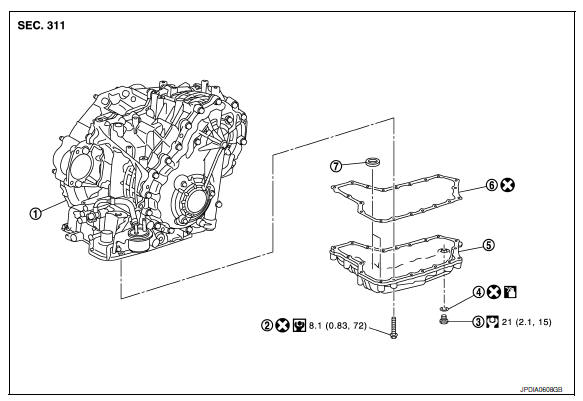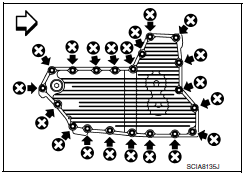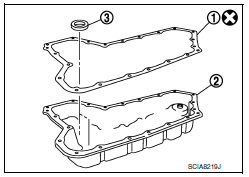Nissan Maxima Service and Repair Manual: Oil pan
Exploded View

-
Transaxle assembly
-
Oil pan bolt
-
Drain plug
-
O-ring
-
Oil pan
-
Oil pan gasket
-
Magnet
 Apply CVT Fluid NS-2
Apply CVT Fluid NS-2
Removal and Installation
REMOVAL
-
Drain CVT fluid from CVT. Refer to TM-156, "Changing".
-
Remove O-ring from drain plug.
-
Remove oil pan bolts (
 ).
).-
 : Front
: Front
-
-
Remove oil pan.

5. Remove oil pan gasket (1) from oil pan (2).
6. Remove magnet (3) from oil pan.

INSTALLATION Installation is in the reverse order of removal.
CAUTION:
-
Completely remove all moisture, oil and old gasket, etc. from the oil pan gasket mating surface of transaxle case and oil pan.
-
Do not reuse oil pan gasket, O-ring and oil pan bolts.
-
Apply CVT fluid to O-ring.
-
Install the oil pan assembly to the transaxle case with the following procedure.
-
Install the oil pan assembly to the transaxle case, and then temporarily tighten the oil pan bolts.
-
CAUTION:
Do not reuse oil pan bolts.
-
Tighten the oil pan bolts in a criss cross pattern to the specified torque.
-
Tighten the oil pan bolts again clockwise to the specified torque.
Inspection
Check foreign materials in oil pan to help determine causes of malfunction. If the CVT fluid is very dark, smells burned, or contains foreign particles, frictional material (clutches) may need replacement. A tacky film that will not wipe clean indicates varnish build up. Varnish can cause valves and clutches to stick and can inhibit pump pressure.
INSPECTION AFTER INSTALLATION
Check for CVT fluid leakage and check CVT fluid level. Refer to TM-155, "Inspection".
 Paddle shifter
Paddle shifter
Exploded View
Steering column assembly
Paddle shifter (shift-down)
Paddle shifter (shift-up)
Removal and Installation
REMOVAL
Park the ...
 Control valve
Control valve
Exploded View
Transaxle assembly
Control valve
Snap ring
Collar
Manual plate
Lock nut
Lock nut
...
Other materials:
Rear power window switch
Removal and Installation
REMOVAL
Remove the rear door armrest finisher. Refer to INT-21,
"Removal and Installation".
Release the pawls on each side to separate the switch finisher
(1) from the rear power window switch (2) using a suitable tool
(A).
: Pawl
INSTALLA ...
System temporarily unavailable
Condition A
When the radar sensor picks up interference
from another radar source, making it impossible
to detect a vehicle ahead, the PFCW system is
automatically turned off.
The FEB system warning light (orange) will illuminate.
Action to take
When the above conditions no longer exist, th ...
Predictive Forward Collision Warning (PFCW) (if so equipped)
WARNING
Failure to follow the warnings and instructions
for proper use of the PFCW system
could result in serious injury or death.
The PFCW system can help warn the
driver before a collision occurs but will
not avoid a collision. It is the driver's
responsibility to stay alert, drive sa ...
Nissan Maxima Owners Manual
- Illustrated table of contents
- Safety-Seats, seat belts and supplemental restraint system
- Instruments and controls
- Pre-driving checks and adjustments
- Monitor, climate, audio, phone and voice recognition systems
- Starting and driving
- In case of emergency
- Appearance and care
- Do-it-yourself
- Maintenance and schedules
- Technical and consumer information
Nissan Maxima Service and Repair Manual
0.0063
